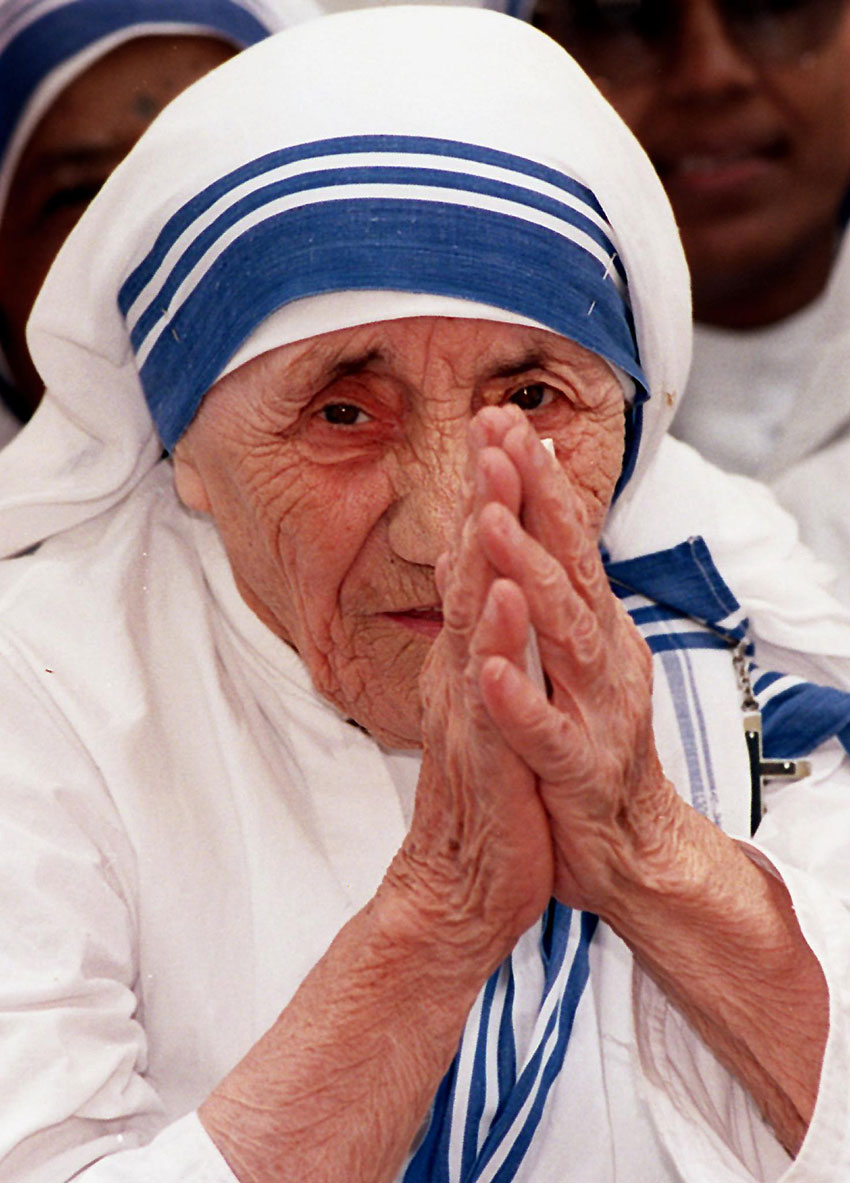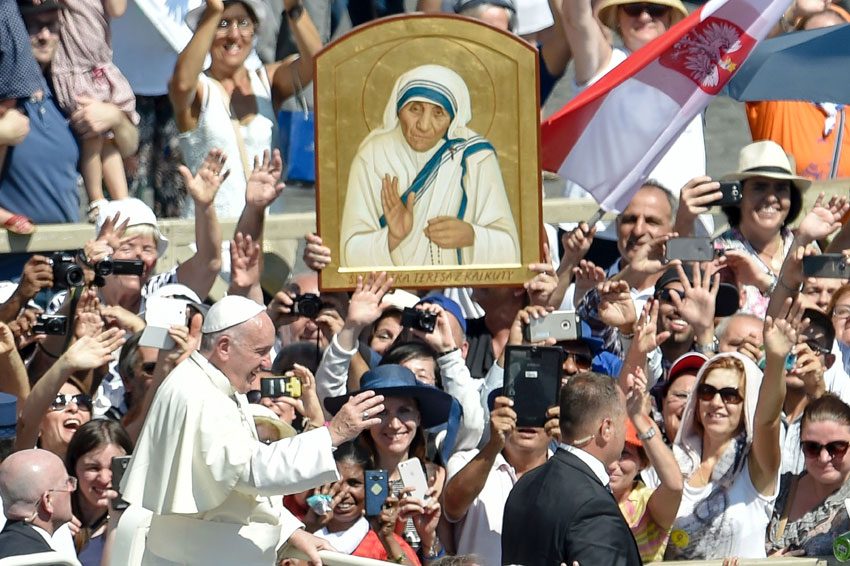‘SAINT TERESA OF CALCUTTA,’ MOTHER ATTAINS DIVINITY

Born in Skopje, the present capital of the Republic of Macedonia, on August 26, 1910, brought up in Ireland, Mother Teresa chose Kolkata, earlier known as Calcutta, in India, to be her city of “karma” where she dedicated her life for the care of the lonely, poor, sick, dying, unloved, crippled, hungry, neglected and tormented, writes Priyanka Bhardwaj. – @Siliconeer #Siliconeer #Sainthood #MotherTeresa #SaintTeresa #MissionariesofCharity #Calcutta #Kolkata #India #People
Irrespective of any discrimination, no suffering soul was turned down by Mother Teresa or her Missionaries of Charity that started in 1950 as a Roman Catholic religious congregation. By the time of her death in September 5, 1997, the institution had expanded to more than 4,000 nuns who formed its human resource and helped run homes, soup kitchens, dispensaries and mobile clinics, children’s and family counseling programs, orphanages and schools in 133 countries.
What set it apart are the vows of chastity, poverty, and obedience, and of providing “wholehearted free service to the poorest of the poor” that the sisters adhere to.
And for such services that no one renders, in the truest sense of the word, thought or deed, Mother attained her place among the saints of the Catholic Church and shall forever live as “Saint Teresa of Calcutta.”
The canonization took place, Sept. 4, in the Vatican, presided by the Pope of the Roman Catholic Church, and her death anniversary on Sept. 5 was designated as her feast day.
Delving into the spiritual life and times of Teresa one finds that she had become a nun in the Loreto Convent but the stimulus for embarking on the “call within the call” came to her during her train-journey from Kolkata to Darjeeling in 1946.
In her diary she explains that this call meant leaving the relative comforts of the convent and helping the poor while living in their midst and sticking to this ‘faith’ in every eventuality.
In two years the young nun had submitted her life to the order of God, and adorned in a simple white cotton sari decorated with a blue border and armed with a basic medical training received in the Holy Family Hospital in Patna, she first set up a school in Motijhil in Kolkata.
Then with a small band of equally dedicated nuns who willingly chose to be led by Teresa in the service of the poorest of the poor and with some help of a few government officials as well as the aid of the then Pandit Jawaharlal Nehru, Mother founded “Kalighat – The Home for the Pure Heart (Nirmal Hriday)” – at the site of an old abandoned Hindu temple in Kalighat in 1952.

Nirmal Hriday became a home for the neglected and dying who received medical attention and were afforded the opportunity to die with dignity, according to the rituals of their faith.
In Mother’s words, “A beautiful death is for people who lived like animals to die like angels—loved and wanted.”
Yet it was a lonely and strenuous mission as she notes in her diary on how she had to walk till her limbs ached searching for food, shelter, blankets and medicines as the demand of essentials far outstripped the supplies.
On such occasions and often when darkness clouded her faith the Mother was tempted to return back to the stability and comfort of convent life, in the initial part of her journey.
Making no bones of it her notes read: “Our Lord wants me to be a free nun covered with the poverty of the cross. Today, I learned a good lesson. The poverty of the poor must be so hard for them. While looking for a home I walked and walked till my arms and legs ached. I thought how much they must ache in body and soul, looking for a home, food and health. Then, the comfort of Loreto (her former congregation) came to tempt me. ‘’You have only to say the word and all that will be yours again,’ the Tempter kept on saying … Of free choice, my God, and out of love for you, I desire to remain and do whatever be your Holy will in my regard. I did not let a single tear come.”
As years rolled on Teresa opened a home for those suffering from Hansen’s disease or leprosy, called the hospice “Shanti Nagar” (City of Peace) and several outreach clinics throughout the city that distributed medication, bandages and food and in 1955 the “Nirmala Shishu Bhavan,” (Children’s Home of the Immaculate Heart) was founded for the orphans and homeless youth.
Undoubtedly, the world woke up to the selfless services so rarely witnessed in human history and both in the form of recruits and charitable donations appreciation started trickling in.
By the 1960s Missionaries of Charity managed many hospices, orphanages and leper houses all over India and then in other parts of the world — in Venezuela in 1965, followed by centers in Rome, Tanzania, Austria, the USA and African countries.
It is impossible to enlist all the work that Mother rendered and much before her sainthood she came to be duly recognized and honored with several awards, including the highest civilian honor in India, 1980 Bharat Ratna, 1962 Ramon Magsaysay Peace Prize and 1979 Nobel Peace Prize.
Notwithstanding this mass appreciation of her genuine public service, criticism too has been galore particularly on her views on anti-abortion and contraception, practice of reuse of syringes, poor conditions of her homes, acceptance of donations from dictators and the passage to sainthood that required three miracles to be established – the first being the cure of a woman by the name, Besra, on the first death anniversary of Mother, that is Sept. 5, and then a Brazilian man, Marcilio Haddad Andrino, recovering from multiple abscesses in his brain due to a relic of Mother Teresa placed near his head, to which he and his wife prayed regularly.
While reverence of the finest order is showered on her in the 1969 documentary film and 1972 book “Something Beautiful for God” by Malcolm Muggeridge as the loving angel, it stands in stark contrast to her negative critique in Christopher Hitchens’ 1994 documentary, “Hell’s Angel” and Aroup Chatterjee’s criticism of her cult of suffering and secret baptisms.
While keeping intact the merits of the case what one cannot negate is that Mother Teresa was to all as she was to one.
In the sea of criticisms and doubts about her I can only add my personal tryst with the Mother when she visited our alma mater, Loreto Convent in Asansol, a sleepy town in West Bengal.
It was on her advice that monthly visits to the special school run by the dedicated sisters of the mission became a part of our school curriculum and we witnessed firsthand the energy, braver and care of the sisters who lead by the example of Mother and in this process our formative young minds were indelibly imprinted with the attitude to derive joy in serving and sharing our happiness with the other children of God.
There was never a doubt that if we took a leper or any suffering person to that center they would be denied of love and care.
So how could even the Vatican deny Sainthood to a person whose life was the epitome of compassion and who took into her arms all those who had been branded as burden to society?
As a former U.N. Secretary-General, Javier Pérez de Cuéllar once said, “Mother Teresa is the United Nations. She is peace in the world.”
Therefore, Mother indeed is “Saint Teresa of Kolkata,” and may her tribe increase!


